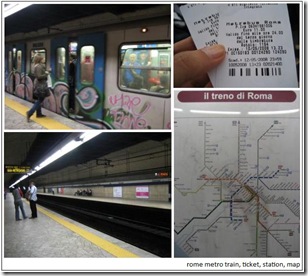London tube system was complicated with 14 color-coded lines. But the tubes ran very fast, it took about 2 minutes in average from one station to the next. The seats were comfortable too, with space in the aisle just enough to fit one row of people.
The oyster card in London worked just like Singapore's EZ link card where passengers needed to tap the card when getting in and getting out of the station, as the charge might be different depending on the distance traveled. It's using contactless card as well. Upon purchase the oyster card was given with a complementary jacket from Ikea.
Metro map in Rome was quite simple, there're only two lines, linea A and linea B. Linea C was still under construction, to be ready in 2015. Trains serving linea A were fine, they looked brand new and clean. However, trains serving linea B looked very old with various graffiti scribbled all over it, sometimes even in the inside. The metro stations were dirty too.
Rome's metro ticket was not contactless. It's using a thick paper, printed by the machine upon purchase. The maximum length for which the ticket was valid was one week. Therefore it was easy to spot dumped metro tickets on public spaces. The same ticket could be used for buses as well.
Waiting for buses in Rome was troublesome. If there were several buses stopping at the same stop, the bus numbers and routes were displayed in several sign boards distributed along the stop area, one sign board could only display 3 buses. So if you were not familiar with the route, you would have to run here and there to check on the sign boards. By the time you're sure that's the bus you need to take, it would have been gone.
The worst of all was metro in Paris. Such a complicated metro map. They had a total of 199 km of track and 15 lines. There were 368 stations (not including regional train stations - RER), 87 of which were interchanges between lines.
Prior to the trip, we'd normally check first what the nearest metro to our destination was and the name of the metro station we were currently at. Next, we found those two names in the map, while figuring out the most convenient route between the two - with minimum travel time and minimum number of transfer. When getting into the metro, we also needed to make sure that we got in to the correct entrance, to ensure minimum headache in the tunnels. The metro station looked like a maze too, a sharp turn with signage could be easily missed. The metro (short of Metropolitain) was first opened in 1900, that explained why some station looked so ancient.
To add to the complication, there was also regional line called RER (Reseau Express Regional/Regional Express Network). It's built to integrate the city-centre subway with the pre-existing regional lines. It had 5 lines as of now with 258 stops, 587km of track.
Metro ticket in Paris was not the usual credit card size. It was smaller, made of paper. I especially am not fond of the entrance to Paris' metro station. When entering, passengers have to slot in the ticket, then at the same time they have to take the ticket back while passing through a turnstile and pushing another metal bar door in front of the turnstile. In addition, the space was small I don't think a fat person could go through. Imagine going through those while carrying heavy, bulky bags!
Metro in Rome and Italy were using flat rate fare, though. So tap out was not required for exit, and mostly the exit doors were automatic, no more handle to turn or door to push. I also noticed that there was no restriction on eating and drinking in the station and on board the train. I even saw some people eating their dinner while seating on the platform waiting for train's arrival. Trash bins could be easily found inside the station and on the platforms. Maybe it was due to the type of the food also.
Sandwiches were fine, but I could not imagine eating laksa or chicken rice on the train or platform :)
People in London, Rome and Paris would wait patiently for alighting passengers before rushing into the train. They would also obediently stay at one side of the escalator - London, Rome and Paris are all on the right. If you stand still on the left side in London tubes' escalator, you would immediately find it out as other passengers would shove you by. In Rome and Paris it wasn't that bad.
After taking the subway in London, Rome and Paris, and in Hong Kong too - sometime back, I think I can now safely say that Singapore's MRT is indeed, world class.. although sometimes I still complain when squeezed like canned sardines inside MRT trains :)



No comments:
Post a Comment